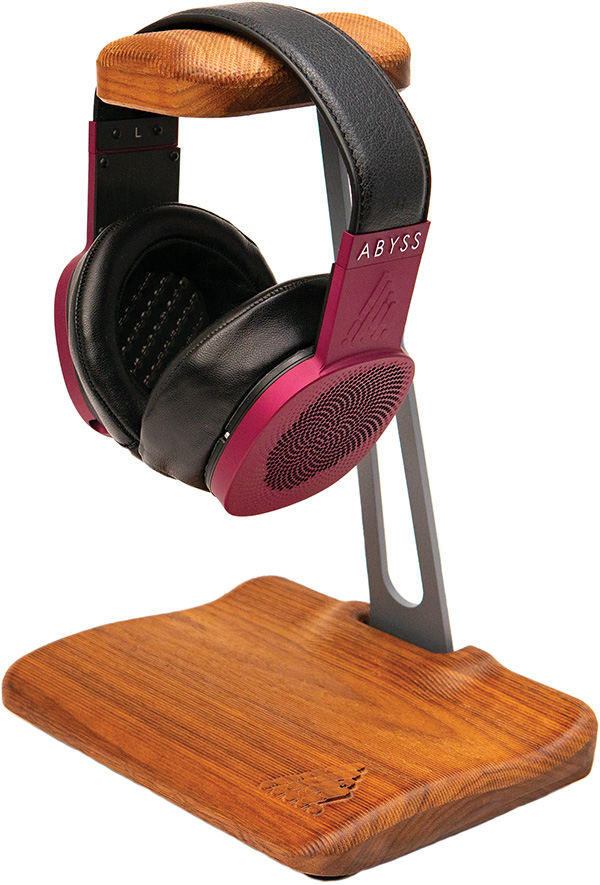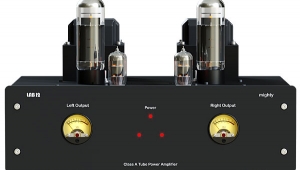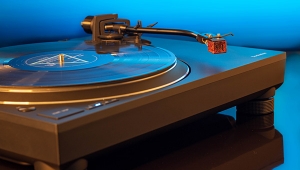| Columns Retired Columns & Blogs |
Gramophone Dreams #72: Abyss Diana & Focal Utopia headphones; Eleven Audio Broadway & Naim Uniti Atom HE amplifiers

Since the 1980s, I've been asking every speaker designer I meet, "What amplifier do you recommend using with your speakers?" Annoyingly, they always say, "My speakers are easy to drive. Any amp will do." Whereupon I'd whine, "Aww, come on man, don't feed me that. What amp did you use when you were designing the speaker?" The closest any manufacturer came to providing a real answer was Wendell Diller of Magnepan, who, when I reviewed his .7 quasi-ribbon speaker, said, "We used an amp of our own design. It's not for sale. But any amp that doubles its power into 4 ohms will be fine." Wendell's answer helped me choose effective amplification and feel more confident about my conclusions.
Footnote 1: Abyss Headphones, a Division of JPS Labs LLC, 16 Lancaster Pkwy., Lancaster, NY 14086. Tel: (716) 288-9112. Web: abyss-headphones.com.
Unlike loudspeaker manufacturers, headphone manufacturers know that which amp a reviewer uses could make or break a review of their product. So, wisely, they seem grateful when I ask for guidance.
When I reviewed Dan Clark's flagship Stealth planar-magnetic headphones in Gramophone Dreams #62, I asked Clark Audio's president, Andy Regan, if he would "please" recommend an amp that he thought would allow the Stealth to perform at its full potential. In response, he sent me HeadAmp's $1995 GS-X Mini headphone amplifier/preamp. This popular, drives-everything headphone amplifier allowed the Stealth and every other headphone I've run through it to reproduce recordings with a grainless, easy-flowing dynamic that makes vocal recordings sound exceptionally natural. Because it is more powerful (6W into 25 ohms, 4W into 50 ohms, 2W into 100 ohms) than the amps described below, I used the GS-X Mini as a reference during the course of this report.
When I review state-of-the-art electrostatic headphones, Woo Audio proprietor Jack Wu loans me his divine $8999 parallel, single-ended 300B 3ES electrostatic amplifier/preamp. For all other types of headphone reviewing, and for daily use, I rely on Linear Tube Audio's uniquely wonderful Z10e, a full-function tube integrated amp that, in addition to powering magnetic headphones, drives electrostatic earspeakers and my reference loudspeakers. Ever since I first raved about it in Gramophone Dreams #36, the $6950 Z10e, which is specified to output 3W into 32 ohms, has been the steadfast anchor of my desktop system, driving my Dynaudio Excite X14 speakers while also allowing me to feel like an old-school headphone connoisseur as I enjoy the luminous charms of my beloved Stax SR-007 Omega electrostatics.
Because the Z10e is the headphone amp I use most, it was perfect for double-checking my findings against the other amplifiers provided for this month's headphone auditions, by Abyss and Focal.
Abyss goes high-fashion
Thirty years ago, Joe Skubinski founded what became a successful audio-cable manufacturing business called JPS Labs LLC. Ten years ago, in his first-ever attempt at designing a headphone, he created what I still consider the state-of-the-art planar magnetic: the Abyss AB-1266 (footnote 1). What are the chances of hitting a home run in your first major league at bat?
When I first reviewed the Abyss AB-1266 Phi headphones back in Gramophone Dreams #17, I found them to be the most open, lightning-fast, microscopically transparent transducers I'd ever used. Their only competition for clarity, detail, and neutral tone were Stax SR-009 electrostatics and AKG's K812 dynamic open-backs. To me, the AB-1266 sounded more conspicuously "right" than any headphone I'd encountered since my audition of Sony's MDR-Z10s from 1989.
Friends who tried the Abyss were in awe of its sound, but all of them took some issue with its form factor.
Besides their vaguely Frankenstein look, my head-fi pals struggled with the fact that the AB-1266 is big and designed to float loosely near the listener's head instead of sealing snug against the skull. This not-unprecedented feature caused the Abyss to fall off when users bent over, and it frustrated measurement geeks because, like horns, omnidirectional speakers, and panel speakers, the AB-1266 is difficult to measure in a way that accurately reflects its real-world performance. Nevertheless, experienced listeners familiar with the sound of distortion knew immediately that the Abyss AB-1266 Phi was one of the lowest-distortion transducers ever invented.
In 2017, Joe got tired of people bitchin' about his headphone's form factor, so he went out and got all Anna Wintour on them, creating what might be the "world's most high-fashion" headphone. Realizing that the AB-1266's unique physical structure did not lend itself to extended casual listening, Skubinski decided to make his new headphone lighter, slimmer, and more comfortable, fitting more neatly onto the user's skull. This second headphone design, which he named after his wife, Diana, employs a slightly smaller (63mm vs 66mm) planar-magnetic driver that was adapted from the AB-1266 in a sturdy, luxurious, aluminum headset. The Abyss website claims it is the "world's thinnest planar headphone." The stock, fourth-generation Abyss Diana TC I'm reviewing costs $4495 and may be purchased direct from Abyss in no fewer than 30 fashion-conscious colors of oven-cured polymer ceramic. Dealers carry only gray and bronze.
What are the chances of hitting another home run in your second at bat?
For this report, Joe sent me what he calls the Complete package, which, at $1500 extra ($5995 total), substitutes a 1.8m Superconductor HP cable for the standard 1.5m cable, in your choice of termination: three- or four-pin XLR or ¼" plug. (Other lengths are available.) In addition, Joe sent along a set of optional ported pads, which JPS offers as an alternative to the stock lambskin or vegan Ultrasuede earcup pads. According to Skubinski, the ported pads "add a gentle bass bump in the lower bass range, adding a bit more soundstage depth and openness."
In my experience, headphone driver technology rarely accounts for more than 60% of how a premium, audiophile headphone sounds. The other 40% is split between cables and earpads. Headphone manufacturers know this, so it's not surprising that Joe Skubinski started his audio life as a cable manufacturer or that mastering the esoteric science of earpad design would appeal to him. His bass-bump pads are very cool: Each pad's magnetic base is thickened by a millimeter or two, providing space for four acoustically shaped ports that exit at the earcup's corners. It was easy to distinguish between the punchier, more direct stock pads and the ported ones, which, as Joe suggested, play a touch warmer and more spacious. It was not easy to choose a favorite.
The Diana TC weighs 390gm (the AB-1266 weighs 640gm) and has a 69 ohm impedance (the AB-1266's impedance is 47 ohms) anda 90dB/mW sensitivity (compared to 88dB for the 1266).
Eleven Audio Broadway
Like Andy Regan and Jack Wu before him, Joe Skubinski sent me his recommended headphone amp, the $2599 Broadway by XIaudio (aka "Eleven Audio" footnote 2). The Broadway is small (8.3" × 6.1" × 1.9"), light (2.5lb), and totally unglamorous looking. It is specified to output 1.5W into 32 ohms in full, differential-balanced class-A. Its only input is balanced (XLR), and its two outputs are both balanced: 4-pin XLR and 4.4mm Pentaconn. Its top plate is easy to remove, exposing a colony of green boards populated by hundreds of anthead-size surface-mount parts.


Besides the volume control and a 3W power resistor, the only normal-sized parts were the four user-replaceable, 3000mAh, 3.7V Li-ion batteries. According to the Abyss website, "This amp will run for up to six hours without AC power, or plug in for continuous play, with the same highly refined sound on either power source. Circuitry is designed to float the batteries on the mains at all times." I asked Joe what that meant. He told me that Michael Xiao, the Broadway's designer, created this fully differential BJT amp to be run entirely off user-replaceable batteries, even when the amp is connected to the charger, and that Michael had gone to great lengths to make sure charging was not audible. Xiao said the cells were chosen for best sound.
I tested Joe's and Michael's claim by listening without the charger for about four hours. I noticed no degradation of sound as the batteries lost charge. Then I connected it to its wall wart and again observed no change in sound quality. I also tried to see how long it would play without plugging in. It shut down after almost six hours.
The Broadway has a 1.0V input sensitivity and, according to Joe's measurements, a healthy 18dB of gain into 50 ohms.

Abyss Diana TC
The Broadway's specified 1.5W into 32 ohms seemed like it might be a little four-cylinder–ish for the heavyweight JPS Labs AB-1266, which thrives on turbocharged V8s. So, naturally, I started these auditions using the Abyss AB-1266 Phi TC, to see if the Broadway could muster enough steam to reproduce the tempestuous Yuja Wang playing her 2018 Berlin Recital (24/96 FLAC, DG/Qobuz). My first impressions were of strength and vigor and fierce forward momentum, from the amp and the artist, with no noticeable clipping or compression.
The AB-1266 played forcefully. More than force, though, what impressed me most about the 1266 with the Broadway amplifier was its delicacy, and how it let sounds start and stop naturally and breathe real air during the sustain, with complete, understated assuredness. No headphone I know manufactures a more richly shaded sonic structure. At my low listening levels, the 1266 and the Broadway worked beautifully together.
I was surprised that, when I switched from the 50 ohm, 88dB/mW-sensitive Abyss AB-1266 Phi TCs to the 69 ohm, 90dB/mW-sensitive Abyss Diana TCs, I had to turn the volume down on the Broadway (footnote 3), and how, with the Diana, the sound seemed to relax a little. When I played "Preludio: Asturias," the first track on La Guitarra dels Lleons (16/44.1 FLAC Cantus/Tidal), with Xavier Díaz-Latorre on guitar and Pedro Estevan on percussion, the sense of urgent, delirious forward momentum was spellbinding and impactful with the 1266s, only slightly less so with the Diana. The 1266s were breathier and more explicit above 2kHz and more vivid and brighter through the upper bass, where the Diana came across as smoother, darker, more luxuriant. The 1266 displayed more of the energized air surrounding Díaz-Latorre's guitar and exposed more of its internal volume. The Diana TCs kept me glued to the performances.
Footnote 1: Abyss Headphones, a Division of JPS Labs LLC, 16 Lancaster Pkwy., Lancaster, NY 14086. Tel: (716) 288-9112. Web: abyss-headphones.com.
Footnote 2: XiAudio, imported by JPS Labs Labs LLC, 16 Lancaster Pkwy., Lancaster, NY 14086. Tel: (716) 288-9112. Web: abyss-headphones.com.
Footnote 3: Volume correlates to voltage, not power.
- Log in or register to post comments




































